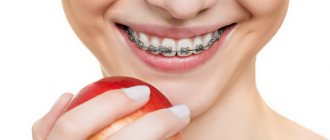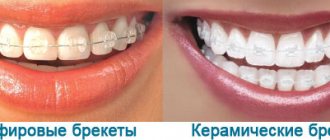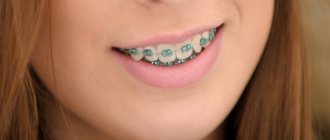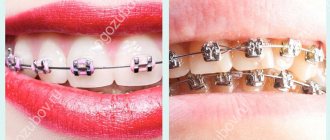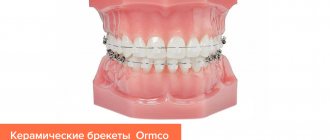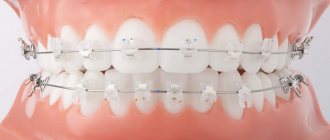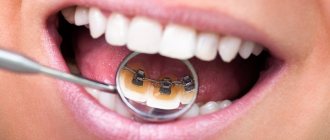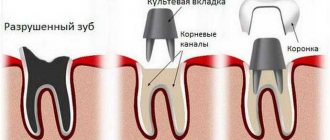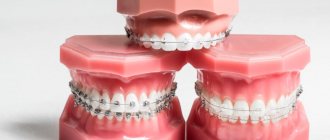Braces are special structures that are used in dentistry to correct bite defects. An incorrect bite not only negatively affects the aesthetics and beauty of a smile, it can cause disruption of the normal functioning of the facial muscles and lead to the development of periodontal diseases.
With malocclusion, the chewing load on the teeth is distributed unevenly and this causes increased wear of the teeth, increases the risk of developing caries and other dental diseases. In case of malocclusion, facial asymmetry may be observed, premature and deep wrinkles may appear. That's how much trouble an incorrect bite can cause, which most people mistakenly consider to be a purely aesthetic problem!
Having decided to correct your bite, you need to contact an orthodontist and together with him choose braces. What braces are best to install so that the treatment goes quickly, with minimal discomfort and is effective? The material we have prepared will help you find the answer to these questions.
Calculate the cost of treatment by taking a short test in 20 seconds!
Do not delay your treatment, because in this matter time plays against us.
How to choose braces for installation on teeth and bite correction?
Having decided to put braces on your teeth to correct your bite, you need to wisely choose the system with which your treatment will be carried out. And this may not be as simple as it seems at first glance, because there are a large number of different types of braces: the systems differ from each other in the material of manufacture, design, and area of installation.
In order not to get confused when choosing braces for installation, you need to study the characteristics of all types of orthodontic structures, and also take into account the following important criteria:
- The effectiveness of a specific type of braces. For example, aesthetic and invisible ceramic and sapphire braces can be placed on teeth only for simple bite defects;
- Convenience of braces for everyday wear. Let us explain with a simple example: many patients want to get invisible lingual braces, but after learning about the long adaptation period and a number of other disadvantages of this type of braces, they choose classic systems for installation;
- Aesthetics. This criterion is of fundamental importance for public people - politicians, models, actors, media figures, as well as for those who do not want to get braces because they are embarrassed that the system’s braces will be clearly visible on their teeth;
- Duration of treatment. So, for example, if you decide to install ceramic braces, you should be prepared for the fact that the course of correction will be longer than when installing metal braces.
When choosing braces for installation, price will also matter. Below we will analyze in detail all the listed criteria for choosing braces.
Personal experienceBraces in adulthood: Expectations and reality
I decided to get braces at the age of 22, in the spring of this year, after a preventive examination with a general dentist. Outwardly, my imperfections were almost not noticeable, the non-specialized doctor did not have strict recommendations, but I suddenly realized that I wanted (and could!) one day see perfectly straight teeth in the mirror. I thought for a few days and signed up for wisdom teeth removal - this is preparatory work before braces. Removal is the most unpleasant part, but the main thing is to get to the dentist-surgeon’s chair (I got a great one!) and endure the anesthetic injection. After the extraction, the doctor describes in detail what can go wrong, but everything can turn out even better than average: immediately after the removal of the first two teeth, I even went to a party - and the party was great.
In parallel with the extractions, I was looking for an orthodontist. Braces are a long-term treatment, so it is important not to make mistakes with your doctor. As a result, the method of “asking good doctors about other good doctors” helped: I chose an orthodontist on the recommendation of a dental surgeon. It’s funny that after frequent visits to dentists, my “third eye” opened, distinguishing between people with imperfect occlusion. Alas, perfectly straight teeth are almost always the result of correction. Acutely noticing the details around is a so-so superpower, the world has turned into a kind of perfectionist hell, but it seems that this period has passed.
I have noticeable metal braces on my teeth. Firstly, the doctor said that they are effective and unpretentious - transparent mouth guards, for example, need to be worn 22 hours a day, they should be removed while eating, that is, after dinner or lunch out of the house, you need to look for a washbasin and put your jaws in order so that put on a mouthguard. Secondly, truly invisible braces cost several hundred thousand rubles; such an investment in my situation does not seem reasonable.
I hardly feel any everyday inconveniences with braces. Teeth usually do not hurt, but it is better to avoid radishes and whole apples. Braces require careful care of the oral cavity with all sorts of devices, but this is generally useful for everyone, a good habit. I was a little worried about braces due to my profession, since sometimes I have important meetings at work. However, in vain: no one attaches any importance to this, and besides, braces hardly worsen diction (these are not children’s records); on the contrary, they can even improve it. I was pleased with the reaction of my loved ones. A loved one said that braces suit me very well (a dubious, but actually a very nice compliment). Friends praised him for his fortitude. Braces have truly added a healthy amount of self-confidence as a conscious and balanced life choice, and I'm so glad I went for it.
Rationally, braces mean straight teeth and health benefits at the cost of certain organizational efforts and time constraints. But when making a decision on an installation, many are confused by irrational things, reinforced by stereotypes in popular culture: “I’m not a teenager, it’s late, I’ll be like Katya Pushkareva, and everyone will point the finger at me, oh, wasted time...” The strangest thing is that I I heard from this episode: “I would like to get braces... but I can’t, I’m afraid that the lower jaw will change and become too masculine, ugly, oh, I should have done it earlier.” The truth is that you don't wake up a new person after getting braces. Passers-by do not hide their children when they see you on the street, flowers do not wither from your smile, a “crown of celibacy” does not suddenly grow on your head. There are reasonable difficulties in installing braces, it is a serious decision, but prejudices here will not help you make a choice.
Photos: nobeastsofierce - stock.adobe.com, goodween123 - stock.adobe.com, bergamont - stock.adobe.com
Which braces are better - ceramic or metal?
Braces can be made from different materials, and the most popular types are metal and ceramic designs. So which braces are better to put on your teeth - ceramic or metal?
It is advisable to install ceramic braces on your teeth if you want to make your treatment invisible to others and maintain the aesthetics of your smile throughout the entire course of treatment. Ceramic braces are durable, do not cause discomfort in everyday use, and are quite effective, but systems made from this material are not without some disadvantages. Disadvantages of ceramic braces include:
- Duration of treatment. Having decided to install ceramic braces, you need to know that treatment using them will be longer than the course of correction with metal braces;
- When correcting complex malocclusions, ceramic braces may be ineffective;
- There may be some difficulties when removing ceramic braces.
Also, when deciding to install ceramic braces, you should take into account the fact that systems made from this material are expensive, their cost cannot be called budget. On average, you will have to pay 200-250 thousand rubles for the installation of ceramic braces and a course of treatment.
How long should you wear braces?
Another common fear of patients is always the duration of treatment. Despite all the promises of doctors and the testimony of other patients that the installation of the structure has practically no effect on the usual rhythm of life, it is always difficult to decide to correct teeth. It seems like I'll have to wear braces forever!
How long do you really need to wear braces? We have already said that in childhood, treatment is faster due to the characteristics of bone tissue, which is still pliable and ready for rapid changes. Therefore, for children, the period of wearing structures is about 6–12 months, and in complex cases or adolescence it can increase to 1.5 years.
For people 20–30 years and older, the average treatment period is 2 years. The teeth are already firmly fixed in their position, and it will be more difficult to move them from their place.
Don't forget that in dentistry everything is very individual. Your case may be exceptional and require unusual deadlines. It is also possible that the bite will correct itself faster than expected. For example, if self-ligating braces are used. The main thing is not to forget to visit the doctor strictly in accordance with his recommendations, so as not to miss the opportunity to shorten the treatment period.
What braces should I use to make them invisible?
Statistics show that adults most often put off orthodontic treatment and braces because they are worried about how their smile will look with braces and plates on their teeth. There is no need to worry about this - in our dental clinic “VENSTOM” in Moscow, you will be offered braces that are aesthetic and invisible on tooth surfaces. For example, with us you can install ceramic or lingual braces, as well as special orthodontic aligners. The ceramics are matched to the tone of the patient’s tooth enamel, so you can safely install such braces and not worry about the beauty of your smile - the ceramic plates will be almost invisible on the tooth surfaces.
Another option for getting your treatment done with braces is to get sapphire braces. Sapphire braces are made from a unique and very beautiful material - synthetic sapphire, which is grown in laboratory conditions. Sapphire braces are completely transparent and therefore their plates will not be visible on the teeth.
But there are also disadvantages to installing sapphire braces. Such braces can be recommended for patients with perfectly white tooth enamel, but if the enamel is naturally yellowish, all aesthetics are lost. Another significant disadvantage of installing sapphire braces is the high price of the service. If you decide to put braces made of synthetic sapphire on your teeth, you should be prepared to pay an amount of 150 thousand rubles and more.
Lingual braces are often called invisible braces because they are placed not on the outer, but on the inner surfaces of the teeth. This area of installation of braces makes them invisible to prying eyes. However, before you decide to install lingual braces, it is worth considering their disadvantages and, in particular, the fact that you will get used to such orthodontic systems for a long time; during the adaptation period you may be bothered by quite strong painful sensations. In addition, people who decide to get lingual braces often complain that installing the system causes diction problems.
Placement of bracket systems
Devices for correcting maxillodental pathologies can be fixed both on the outside of the dentition and on the inside. Models installed on the front surface of the teeth are called vestibular. Their effectiveness has been proven over decades of successful treatment of patients, so they are extremely in demand.
Modifications of corrective structures that are fixed on the teeth from the tongue side are called lingual. This option is most suitable for people who want to hide the therapy process from prying eyes. Disadvantages include the high cost of therapy and the inability to correct some complex clinical cases. The specialists of our dental center recommend reliable products made in Germany by WIN and INCOGNITO.
What braces should I use to make the treatment as effective as possible?
It is incorrect to answer the question about the effectiveness of certain types of braces in absentia. You need to see the clinical picture, establish the type of malocclusion and its degree, and only then decide which braces to install so that the treatment proceeds quickly and with a guaranteed positive result.
All this can only be done in a clinic, and if you decide to get braces, you definitely need to visit a consultation with an orthodontist! Come to our dental clinic in Moscow - “VENSTOM”: after diagnosis, our clinic specialists will recommend you several types of braces, the installation of which will help quickly and effectively solve your bite problem. From the proposed types of systems, you can choose the one that suits you in terms of treatment time, price, aesthetics and other criteria that are important to you!
Contraindications for occlusion adjustment in adults
Unfortunately, not all patients who need to correct jaw anomalies can have braces. There are absolute and temporary contraindications.
Absolute:
- installed implants;
- lack of teeth;
- endocrine diseases;
- mental illness;
- pathology of bone tissue;
- oncology;
- blood diseases.
Temporary:
- acute infections;
- presence of dental diseases;
- enamel damage;
- poor hygiene (stones, plaque);
- bruxism;
- pregnancy.
What braces are best to install to save on treatment?
What braces are best to install so that correcting your bite won’t cost you an astronomical amount and is it possible to save money on installing braces without risking your health? If you have a limited budget for orthodontic treatment, you can install metal braces that have an affordable price and be sure to ask your orthodontist to draw up a treatment plan, which will indicate the price of installing turnkey braces.
Please note that the price of installing turnkey braces will include not only the cost of the system itself, services for fixing it on dental surfaces, but also the cost of regular visits to the clinic necessary to monitor the results of treatment and correct the position of the braces arch.
If you decide to get regular metal braces, the treatment will cost you 80-100 thousand rubles. When choosing ceramic, sapphire, lingual or self-ligating braces to correct your bite, the costs will be more significant.
Cost of dental braces
Prices for designs can vary greatly. This depends on several factors:
- material of manufacture;
- method of fastening;
- places of fixation;
- clinic location;
- the equipment used and the presence of its own laboratory in the institution, etc.
The cheapest are metal ligature models. Unligated metal staples will cost a little more. The most expensive ones are ceramic, sapphire and lingual (invisible). The latter will hit your pocket the hardest.
Usually the total cost includes the mechanism itself, fixation, dismantling and correction, scheduled visits to the dentist, and retainers. For a fee, preliminary diagnostic procedures are carried out, and elements damaged due to the patient’s fault are replaced.
Many modern clinics offer installment plans. Dental also provides the opportunity to use all services with deferred payment.
Should I get plastic braces?
In dentistry, to correct your bite, you may be offered plastic braces - quite inexpensive and at the same time aesthetically pleasing. However, you need to take into account that such braces are fragile, their installation will be ineffective in case of serious bite defects, and in addition, if you decide to install plastic braces, you will be forced to follow a fairly strict diet that prohibits the consumption of solid food.
Can you get plastic braces or is it better to opt for another type of braces? Only an orthodontist can answer this question after examination and diagnosis.
Indications and contraindications
The brace system is indicated for malocclusion. Uneven teeth are considered the main indication, but in addition to this, doctors recommend installing braces in the following cases:
- Curled teeth. If the teeth are spaced too tightly, the oral microflora will develop faster. At the same time, with increasing load, the enamel becomes thinner and the risk of caries increases.
- Disproportional development of the jaws. If the defect is left unattended, the chewing process may be disrupted. The cause of this phenomenon may be the bad habit of chewing pencils or sucking fingers.
- Dystopia. This term means a displaced position of a tooth - its extension from a row or rotation.
- Gaps between teeth. Braces can be used to restore normal dental density. The problem may be related to tooth loss or may be genetic.
Installation of braces is not possible if the following contraindications are present: too many teeth are missing, diseases of the immune system, blood diseases, endocrine diseases, HIV, neuropsychiatric disorders have been identified.
What braces can be placed on adults?
Age is neither a limitation nor a contraindication to installing braces. An adult can choose any type of braces from absolutely any material. When choosing braces for an adult patient, the main criteria will be the person’s wishes regarding aesthetics, timing and price of treatment.
If you want no one to know that you wear braces, you can recommend ceramic, sapphire or lingual braces. If the bite defects are insignificant, then you can install not even braces, but orthodontic aligners.
If you want the treatment to go quickly, you should opt for classic metal vestibular braces. If the patient does not want to visit the clinic too often during treatment or he simply does not have such an opportunity, you can consider the option of installing ligature-free braces, the correction of which requires much less frequent correction compared to ligature systems.
Calculate the cost of treatment by taking a short test in 20 seconds!
Do not delay your treatment, because in this matter time plays against us.
Classification according to the principle of operation: ligature or non-ligature (self-ligating) braces
Depending on the type of fixation of the power arc to the clasps, braces can be ligature or non-ligature. Below we will look at the features of these two principles of system design.
Ligature braces involve the use of special elastic bands that gradually stretch. Therefore, the client has to visit the dentist monthly, or even 2 times a month, to check the tension of the arc and replace the ligatures if necessary.
Self-ligating braces (also known as non-ligating braces) - the clasps have special grooves in which the arch is fixed . This is a more modern solution that allows you to reduce the number of visits to the orthodontist to once every 2-3 months. This allows for smoother tooth movement. Also, it is easier to get used to non-ligature braces, and they help reduce treatment time and give a more predictable result.
What braces are recommended for children?
Braces for installation on a child should be chosen so that they do not cause discomfort to the child during everyday wear, do not make him feel embarrassed about his smile, and at the same time are strong enough.
Experts advise placing children with classic vestibular metal braces, which 100% meet the requirements discussed above. And you don’t need to worry that such braces will look ugly. The plates of metal braces can be made in the form of various funny figures or symbols and painted in different colors. Children love these braces and not only enjoy wearing them, but also show off their braces to their friends.
Types of bite
There are several types of correct and incorrect bite.
The types of correct (physiological) bite include:
- straight;
- orthognathic;
- physiological prognathia;
- physiological opistognathia.
These types of malocclusions are widespread and do not lead to any problems with teeth or overall health.
There are more varieties of abnormal, pathological bite:
- distal. Characterized by a large sagittal fissure (from 6–9 mm). The teeth of the upper jaw protrude strongly forward. Most often, genetic predisposition is to blame for this type of bite. Possible reasons lie in the early removal of lower primary teeth, bad habits, etc.
- deep bite In this case, the front teeth of the lower and upper jaws do not touch at all - the upper jaw completely “overlaps” the lower one. Most often, such a bite occurs due to different sizes of the upper and lower front teeth, early removal of baby teeth, and bad habits.
- open bite. With this anomaly, the front or lateral teeth on the lower and upper jaws do not touch each other. The jaws do not close completely. Very often, such a bite appears due to sucking a pacifier or thumb in childhood, the habit of breathing through the mouth, and for other reasons.
- mesial. In a mesial dentoalveolar bite, the lower incisors protrude forward and the lower incisors protrude backward. With a gnathic bite, the upper jaw turns out to be smaller than it should be with a normal bite, and the lower jaw is larger.
- crossbite. In this case, the teeth on the upper and lower jaws do not match each other in size and shape, grow incorrectly, and the jaws do not close completely. Such a bite, in addition to heredity, is caused by bruxism, rapid loss of baby teeth, swallowing problems and other reasons.
- edentulous Part of the teeth (usually the lateral incisors) are missing, as a result the jaws are formed incorrectly, and the spaces between the teeth may increase. The causes of edentia have not been precisely established: these may be disturbances in embryonic development, heredity, or illnesses of the mother during pregnancy.
- crowding. This anomaly is common and is characterized by the incorrect position of the teeth on the jaws. They are located too close to each other and grow unevenly. In the past, treatment was limited to the removal of quarter premolars. Today, in 70% of cases this can be avoided.
- diastema and trema. This phenomenon is the opposite of crowding: the teeth are too sparsely spaced, there are gaps between them (three spaces - between the lateral teeth, canines, diastemas - between the front teeth).
As you can see, there are many types of pathologies, and each case requires special treatment.
